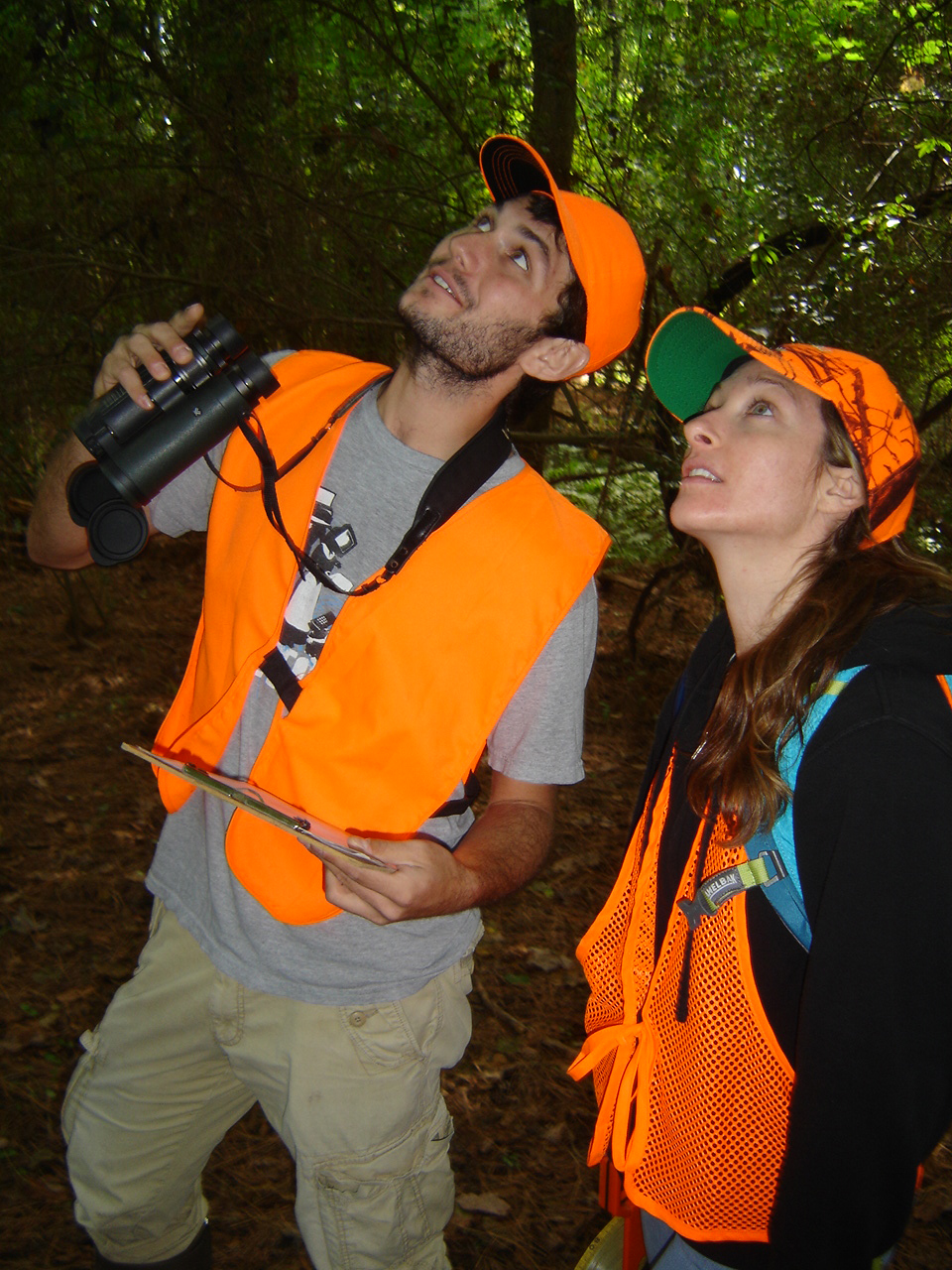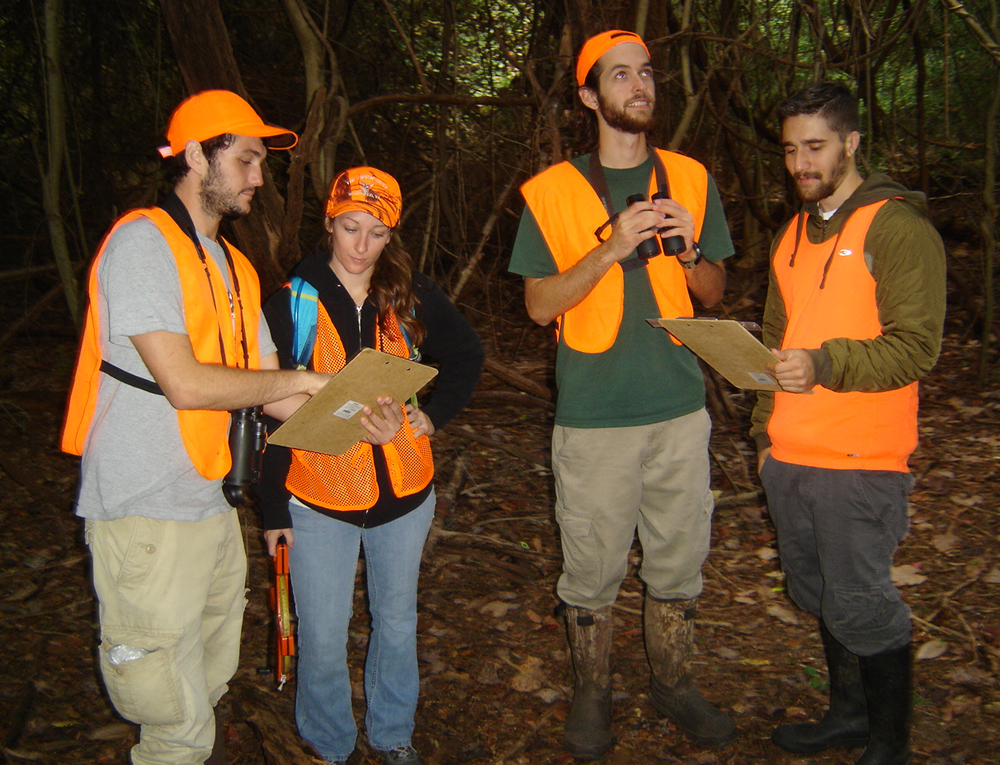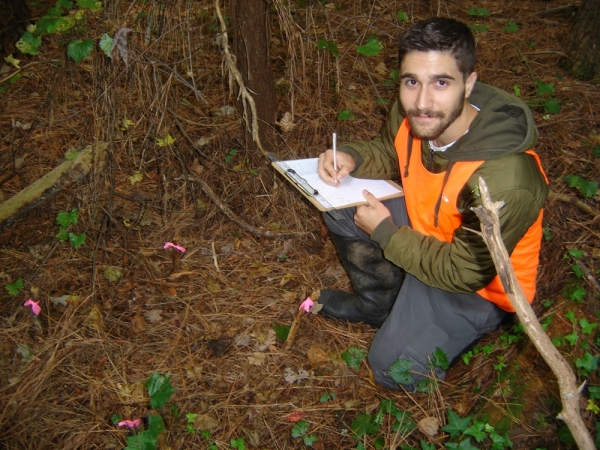Bird Survey Aims to Preserve Migratory Habitats
October 01, 2013
 Team leader Andrew Arnold and Joy Miller look for migratory birds at Hoffler Creek Wildlife Refuge in Portsmouth.
Team leader Andrew Arnold and Joy Miller look for migratory birds at Hoffler Creek Wildlife Refuge in Portsmouth.
 Andrew Arnold, Joy Miller, Connor Higgins and Eric Cali log in songbirds they have identified.
Andrew Arnold, Joy Miller, Connor Higgins and Eric Cali log in songbirds they have identified.
 ODU student Eric Cali checks forest floor plot for insects and spiders that birds could eat.
ODU student Eric Cali checks forest floor plot for insects and spiders that birds could eat.
They look too young to be your stereotypical birders, but this team of researchers led by Old Dominion University graduate student Andrew Arnold is busy on a crisp September morning toting binoculars and clipboards through the Hoffler Creek Wildlife Refuge in Portsmouth looking for evidence that could help preserve habitats for migrating songbirds along the mid-Atlantic coast.
Arnold's adviser, Eric Walters, is an assistant professor of biological sciences at ODU and one of the leaders of a bird migration study that covers Virginia, Maryland and Delaware. The project, which will extend into mid-2015, is a collaboration between ODU, the University of Delaware, The Nature Conservancy, NASA, the Virginia Department of Environmental Quality, the Maryland Department of Natural Resources and the U.S. Fish and Wildlife Service.
There are two segments of the work. The first, led by Jeffrey Buler, a radar ecologist with the University of Delaware, involves radar tracking of migratory birds. The second, led by Walters, requires "boots on the ground" surveys to try to validate the radar data.
So why is $250,000 in government funding and thousands of hours of research needed to track migrating birds? Couldn't a few spotters with binoculars do the job?
The short answer is "no," but the explanation is a long one. First, forget what you know about the migration of big birds such as the geese that fly in ostentatious wedges.
Songbirds can pass through Hampton Roads like ghosts. These smaller birds sometimes don't migrate in big flocks and they tend to fly at night. They rest and feed during the day in plots with trees or shrubs.
Scientists such as Buler have settled upon the method of tracking songbirds with radar to find where they like to make rest stops, mainly so that governments and private conservation groups can know what habitats to try to protect from development. For the current project, an assortment of radar units used by the National Weather Service and NASA is providing base data. NASA's NPOL radar is used primarily to track and measure weather phenomena, so it is sensitive enough to pick out individual raindrops. Songbirds typically do not migrate in the rain, so the radar can be used to track birds on clear nights.
Still, radar so sensitive that it can identify single raindrops can also detect other targets like bugs or bats, which may be confused with birds. That is why the "boots on the ground" surveys are necessary to validate the rest-stop areas that Buler has identified.
Walters' research team at ODU is responsible for ground surveys of 12 sites in southeastern Virginia, 12 on the Eastern Shore of Virginia and 12 on the Eastern Shore of Maryland. Buler's team at the University of Delaware is responsible for 12 sites in that state.
"Our ODU team is trying to ground-truth the data that the radars are picking up," Walters explained. "We have used several years of radar data to come up with maps that predict high and low abundance of migratory birds in the fall. The radar data point to areas of hardwood forest where migrants stopover. During fall migration they often will travel all night and then land in forested habitat as the sun rises. The birds use these stop-over habitats to refuel and rest throughout the day. As sunset approaches, they take off and continue their journey south. We are investigating what species are found at these stop-over sites, what they are eating, what sort of habitat they are using, and how our ground-truthing data compare to what the weather radar stations show with respect to migrant bird activity."
Walters said the ground study is "the first of its kind to try and validate what the radar ecologists tell us is happening."
"The fact that we have so many collaborators is also novel. It took us about a year to bring this project together, but it is a very exciting project and should lead to important findings that will affect future conservation efforts of much-needed stop-over habitat along the mid-Atlantic, one of the major flyways in the United States."
On that morning in September at the Hoffler Creek Wildlife Preserve, Arnold is conducting a survey that puts him close to the confluence of the James and Elizabeth rivers in Portsmouth. He is a master's program student with a bachelor's degree in wildlife science from Auburn University in Alabama, and the team working with him for this research visit includes two ODU undergraduates, Joy Miller and Eric Cali, who are getting biology research credits for helping with the project. The technician for this visit, Conor Higgins, is the team's crackerjack birdsong identifier, and his prize audible on this day will come from a Black-throated Blue Warbler.
"Our highly trained field observers head out to the research sites at dawn and walk transects, detecting birds by both sight and sound," Arnold said. "They are also assessing insect and fruit abundance, both important sources of food for many migrant species. As the season progresses, we will monitor changes in species and how the various species are using the different areas we are studying."
All of the research sites are a minimum of four hectares in size, which is just short of 10 acres. Other than the Hoffler Creek preserve, sites nearest to ODU include Paradise Creek Nature Park in Portsmouth, ODU's Blackwater Ecological Preserve in Zuni, multiple locations within the Dismal Swamp, Chippokes Plantation State Park in Surry County and Kiptopeke State Park on the southern tip of the Eastern Shore.
The surveying started on Aug. 15 and continues until Nov. 15 in order to cover the fall migration.
"The first waves of migration are just starting, so we have mainly been getting resident species so far," Arnold said while he observed his team at the Hoffler Creek preserve. "The expected species include anything found within hardwood habitat, as well as the occasional flyover. Most of the birds seen and expected are pretty small (warblers, vireos, wrens), but we have had our fair share of larger birds, such as owls and hawks. Some of the sites definitely have resident raptors, and I have enjoyed seeing a Broad-winged Hawk multiple times at Paradise Creek, and hearing the Barred Owls almost every morning we go to Blackwater Ecological Preserve."
Arnold said some of the most entertaining incidents so far involved Ruby-throated Hummingbirds. "They come and inspect our pink flagging and orange vests."
On other occasions, his team members have come across a fox and a few nonvenomous snakes. "Also, when one technician was counting fruits and pulled a branch back, he revealed an Eastern Screech Owl just a few feet away. It was super tiny and adorable."
As for the food they are finding for the birds, Arnold said the most common bugs are spiders. American holly berries seem to be the No. 1 fruit, but at Hoffler Creek refuge the natural arbors of muscadine grapes are inviting for birds, and for birdwatchers. "My family grows muscadine grapes," Arnold said. "I knew them immediately when I saw them."

